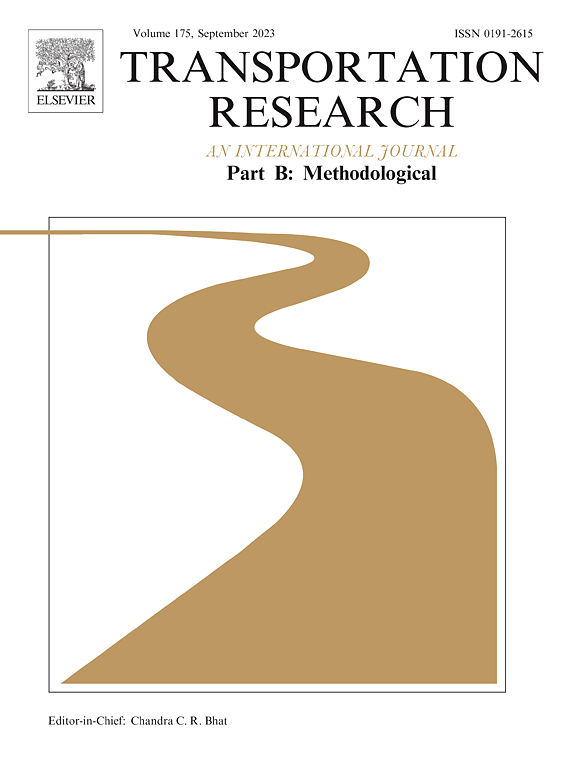与现有地铁系统相协调的分层公交网络设计
IF 6.3
1区 工程技术
Q1 ECONOMICS
引用次数: 0
摘要
一个协调良好的地铁-公交双峰系统的建设不仅可以使双峰出行的乘客受益,也可以使使用每一种交通方式的乘客受益。为此,本文的重点是共同设计公交网络,确定公交线路的频率,以确保与现有地铁系统的协调运行。特别地,为了达到更好的多式联运协调,提出了一种由不同类型的公交线路组成的分层公交网络结构,而不是实施单一的规则线路类型。每条线路都有特定的停车模式、商业速度水平和终点站。提出了一种新的基于站点间距离的模型,以确定不同类型线路的数量和路线以及适当的公交车频率,从而在容量限制下使双峰网络中的总乘客旅行时间最小化。同时,引入多项logit模型,明确地捕捉了内源性多式联运乘客分配与服务水平和票价的关系。为了有效地解决分层网络设计问题,定义了改进的分层虚拟路网的概念。在此基础上,提出了一种双层次启发式分解方法,将集成问题分解为两个更简单的子问题,然后迭代求解。此外,在求解过程中,利用内部的乘客需求信息在多个专门的算子中进行求解,加快了算法的收敛速度,提高了解的质量。考虑三种线路类型的网络设计实例的结果表明,分层公交网络通过在不同平均站间距离的不同运行速度的线路之间进行权衡,可以激励通勤者进行路线选择,从而提高地铁-公交双峰综合网络的整体系统性能。本文章由计算机程序翻译,如有差异,请以英文原文为准。
Hierarchical bus transit network design in coordination with an existing metro system
The construction of a well-coordinated metro-bus bimodal system may benefit not only passengers performing bimodal trips but also passengers using each individual transit mode. With this aim, this paper focuses on jointly designing a bus network and determining the frequency of bus lines to ensure coordinated operation with an existing metro system. In particular, rather than implementing a single regular line type, a hierarchical bus network structure consisting of different types of bus lines is proposed with the objective of reaching better intermodal coordination. Each line type is characterized by a specific stopping pattern, commercial speed level, and terminal stations. A novel inter-stop distance-based model is proposed to determine the number and the itinerary of the different types of lines and the appropriate bus frequencies so that the total passenger travel time in the bimodal network is minimized under capacity limitations. Meanwhile, a multinomial logit model is incorporated to explicitly capture the endogenous multimodal passenger assignment regarding service level and ticket price. To efficiently solve the hierarchical network design problem, the concept of an improved hierarchical virtual road network is defined. Based on it, a bi-level heuristic decomposition method that breaks down the integrated problem into two simpler subproblems and then solves them iteratively is presented. In addition, the passenger demand information is used internally by the solving procedure in several specialized operators to accelerate the convergence of the algorithm and improve the quality of the solutions. The results of a small-scale case and a real-world network design instance considering three types of lines show that by making a trade-off between lines with different running speeds resulting from different average inter-stop distances, the hierarchical bus network can incentivize commuters into route choices that improve the overall system performance of the integrated metro-bus bimodal network.
求助全文
通过发布文献求助,成功后即可免费获取论文全文。
去求助
来源期刊
CiteScore
12.40
自引率
8.80%
发文量
143
审稿时长
14.1 weeks
期刊介绍:
Transportation Research: Part B publishes papers on all methodological aspects of the subject, particularly those that require mathematical analysis. The general theme of the journal is the development and solution of problems that are adequately motivated to deal with important aspects of the design and/or analysis of transportation systems. Areas covered include: traffic flow; design and analysis of transportation networks; control and scheduling; optimization; queuing theory; logistics; supply chains; development and application of statistical, econometric and mathematical models to address transportation problems; cost models; pricing and/or investment; traveler or shipper behavior; cost-benefit methodologies.

 求助内容:
求助内容: 应助结果提醒方式:
应助结果提醒方式:


